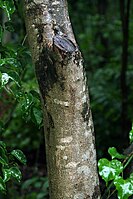|
Lysiloma divaricatum
Lysiloma divaricatum is a flowering tree native to Mexico and Central America. Common names include mauto, quitaz, and tepemesquite in Mexico, quebracho in Costa Rica, Honduras, Mexico, and Nicaragua, and quebracho negro, tepemisque, and yaje in El Salvador.[2] DescriptionLysiloma divaricatum is typically a small to medium-sized tree, densely branched, with an open spreading crown up to 15 meters high.[2] Distribution and habitatLysiloma divaricatum ranges from northern Mexico to Costa Rica.[2] It is found in tropical and subtropical dry deciduous forest, mixed pine forest, and occasionally in desert scrub with cactus. It ranges from sea level up to 1100 meters elevation, and occasionally up to 1750 meters. It is often found on slopes growing on volcanic and sandy clay soils.[2] In Baja California it is commonly associated with Caesalpinia pannosa. Elsewhere it is often found with other dry forest species like Chloroleucon mangense, Leucaena macrophylla and Senna mollissima, along with species of Acacia, Parkinsonia, Calycophyllum, Mimosa, Myrospermum, and Burseraceae.[2] Gallery
ConservationThe population is considered stable, and the species is assessed as Least Concern due to its wide distribution, large population, and absence of major threats.[1] ReferencesWikimedia Commons has media related to Lysiloma divaricatum.
|
||||||||||||||||||||||||||||||||||||||||
Portal di Ensiklopedia Dunia



